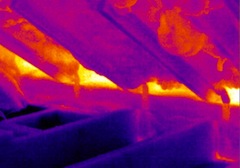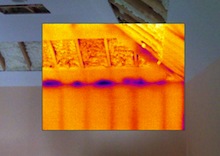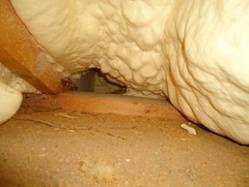GUEST POST: Spray Foam, Infrared Cameras, & the New Big Holes

After reading an article by Joe Lstiburek titled Just Right and Airtight, I got to thinking about what we’ve been spending a lot of time on lately, and that is what we call the “New Big Holes.” Of the 350+ spray foam encapsulations we have tested with a Blower Door and infrared (IR) camera, it’s safe to say there are lots of “New Holes” being created from incomplete spray foam installations. It also reminds me of Allison Bailes’s article, Infiltration Occurs at the Surface, Not in the Volume. The problem is you gotta know your surface!
I agree the Blower Door may not be needed to find those “Big Holes” Joe writes about, but these “New Holes” in spray foam installations cannot be found otherwise. Whether it’s closed-cell or open-cell spray foam, the foam leaves the applicator as a molten liquid and expands rapidly once it hits the surface to which it is applied. As this chemical reaction occurs, the rapid expansion leaves opportunity for pockets, or holes, to be formed and not seen. The holes are not “in” the foam itself, but behind it, beside it, around it, or covered by it. Most of the time, they’re hiding!

Foam inherently is not smooth, so it is not easy to know which lump is covering a hole from a visual inspection alone. We have been finding these bypasses by running the blower door and using an IR camera to go and search for these breaches. Some are dime-sized, some are apple-sized, and many are larger.
Sometimes the foam looks perfect, but there’s a space between the top plate, and the foam coming down from the roof deck. There are times the envelope edge is completely missed and even times when the old fiberglass batts have not been removed and the foam is sprayed directly on top of the pink stuff, creating a deceivingly incomplete attic encapsulation. You can’t find these holes from a Blower Door number alone. You have to search for the air with the Blower Door running and by using smoke, IR, and your hand to discover the breach.
edge is completely missed and even times when the old fiberglass batts have not been removed and the foam is sprayed directly on top of the pink stuff, creating a deceivingly incomplete attic encapsulation. You can’t find these holes from a Blower Door number alone. You have to search for the air with the Blower Door running and by using smoke, IR, and your hand to discover the breach.
These “new holes” can form anywhere, but mostly we’re finding them near the top plates, at hip rafters, below kneewalls, and around architectural details in the building envelope. These bypasses in spray foam insulation are the cause of mysterious problems that HVAC contractors have to fight. To date, we have helped many homeowners who were experiencing problems with high humidity, condensation, mildew, and other problems in their newly spray foamed attics and homes.
The clients we’ve helped had no idea the problems were related to the foam’s incomplete seal. They got to us after the HVAC contractor had done all they could to hold the problems at bay, many times adding a dehumidifier to the space. Here in Savannah, GA and Hilton Head Island, SC, allowing humidity and ambient air to infiltrate into the home and get trapped in the newly (almost) encapsulated attic is a problem. This warm, moist air normally exhausted out of the ridge vent, but is now trapped and allowed to migrate into the home’s materials and indoor air. This  problem is eluding many, if not most, of the spray foam insulators we know, and probably is happening in your area too.
problem is eluding many, if not most, of the spray foam insulators we know, and probably is happening in your area too.
I do believe in foam and live in a spray foamed home. Spray foam is a great product, but it is not a magic product. It takes a skilled operator and needs to be tested to make sure that the job gets done properly. The bottom line is, what you see is not always what you get, so have your job tested and don’t just pay attention to that ‘target’ blower door number, look for the holes that may cause problems before they find you.
by Jamie Kaye of Elm Energy Group in Hilton  Head, SC. Jamie is a certified HERS rater, BPI Building Analyst, Level 1 Thermographer, juggler, and all-around great guy. I met him a couple of years ago when he took the HERS rater class, and we got to juggle together every day at lunch. I’m sure he’ll be one of the very first certified Home Energy Jugglers.
Head, SC. Jamie is a certified HERS rater, BPI Building Analyst, Level 1 Thermographer, juggler, and all-around great guy. I met him a couple of years ago when he took the HERS rater class, and we got to juggle together every day at lunch. I’m sure he’ll be one of the very first certified Home Energy Jugglers.
Related Articles
4 Pitfalls of Spray Foam Insulation
A Dramatic Illustration of a Compromised Building Envelope
Batts, Blown, or Sprayed – What’s the Best Attic Insulation?
Photo credits: All insulation photos by Jamie Kaye.
This Post Has 13 Comments
Comments are closed.

I also recently read the
I also recently read the article by Joe Lstiburek, and agree that a seasoned installer wouldn’t need a blower door to find most major air sealing opportunities. But I think our friend David Butler said it best in a recent conversation we had when he told me ” I tell my clients if your dealing with a spray foam installer or for that matter a HVAC installer that doesn’t use a blower door during their install process, then they are selling you snake oil, because you never know if your getting what your paying for.”
As a Thermographer/Rater, I
As a Thermographer/Rater, I’ve seen plenty of grade I foam jobs sink to a grade III. I suspect this is the reason that IR is no longer applicable to ES Version 3 since an IR survey will only get you a grade 2 (even on the rare chance it turns out to be a grade I).
Good comments. I have
Good comments. I have frequently seen the significant gaps once the foam shrinks and pulls back away from a wood or concrete surface.
I too agree that spray foam
I too agree that spray foam is often not the “quick fix” that a simple visual inspection or marketing materials make it out to be. And be careful of the contractors who want to apply sheetrock to the studs immediately after foam installation. In the name of hurrying the job along – and often to the praise of the homeowner – they are often covering up mistakes. We have seen many cases of foam losing adhesion to the very studs it was supposed to stick to. This is often due to when foam was applied on a cool morning – and cool studs do not allow for good adhesion like warm studs do. We also know that many installers do not fill the stud cavity completely, and when you have air gaps of greater than 5/8″ in thickness along with temperature differentials (cool sheetrock/warm studs, or vice versa) you will have micro-air circulation or eddy currents – and moving air wreaks havoc with R values as well.
Great article Jamie. These
Great article Jamie. These things need to be understood by all the builders, insulators and home performance professionals who think foam is magic.
Getting a good envelope is all about details. There’s no magic. Most people buy foam based on faith. I tell my clients that if they’re going to do the heavy lifting anyway (e.g, getting the details right), they might as well do it with cellulose or BIBs and apply the savings to better windows or more R-value.
@Jeremy, appreciate the nod.
Thanks Allison for posting
Thanks Allison for posting this article. I am very passionate about this as it has provided for some unneeded push-back against the product while many of those insulators are not paying attention to the snowball of issues they are creating. Although Chris is right about some of the potential IAQ problems that seem to be lingering, I am still in the camp of getting a good installer and bring in that fresh-air! I do love the foam!
Jeremy: Thanks for the comment. I agree that all spray foam contractors and HVAC contractors should be using the tools we do, but I also think the “fox watching the hen house” can cause problems. Many of them are “snake oil” salesmen, but there are some great ones around here that want to be different and care about what they do. The problem is people are buying price and not the costs!
George: I have never done a IR survey for an ES home. I know that is was possible, but with thermography, timing is critical, so I am okay with these builders having to let us see the foam and touch it and stop moving so fast. This also touches on Charles’ comment with the drywall being rushed after the insulation. That is not the best way to look out for the long term sustainability of a home!
Clough: I see that often. In the big picture, the “Flat vs. Lumpy” article by Allison comes into mind.
Chris: Thanks for the “Thanks!” EVER has been such a good partner for me. You all are always there and always thinking and engaged. Thank you all!! You couldn’t have said it better “Preparation, patience and diligence leading up to and during the installation tend to go a really long way.”
David: Thanks and I agree with you that if those details are run by the homeowner or builder anyway, then put that money to use elsewhere. Your insight is always profound. I often talk about your approach to “over-insulating” and how it should be planned and analyzed, not just completed. The key is to use that better defense to need less offense…in the words of Allison. The problem is we see over-insulated homes with 1 ton per 500 or 600 square feet because no one is talking!!
Thanks for bringing up this
Thanks for bringing up this important issue. Despite asking my project manager/Rater to pressure test the newly encapsulated attic while the foam truck was still onsite, I had to have major repair as you described to my own home 6 years ago. I warned them that I would be checking the work. It’s just much more difficult to seal over Swiss cheese & in tight quarters than new construction. In our Rater & BPI courses, I always recommend including performance requirements in the contract.
Btw, yay for folks who have earned Level I Thermographer cert!
Jamie wrote:
Jamie wrote:
> I also think the “fox watching the hen house” can cause problems
Just to be clear, my position is that foam insulators should be using a BD to QA their crews, not that this becomes a substitute for 3rd party verification.
That being said, if I were a 3rd party verifier and I have good experience with a foam crew who tests its work as a matter of process, I would be inclined to accept their final test reports — subject to unannounced spot testing of course — to the extent allowed by whatever program the home may be participating in.
I see the blower door as a “tool of the trade” for any insulator who sells air tightness, much like a plumber uses a pressure gauge to test water and gas lines during rough-in. Ditto for HVAC contractors and duct pressurization testing. Your point about using thermography with BD to identify weak spots is spot on. Thanks for bringing this up!
I should also clarify that it’s not my intent to imply deception with the snake oil salesman label. But the end result is nonetheless the same. Interestingly, in my experience, foam crews who use a blower door quickly learn how to be efficient both in terms of time and material, so the price objection for adding a quality control step is a red herring in my opinion. In any case, crews who do it right deserve a fair price for their work. As with much of what of we do, builder education is the key. And even though I don’t often recommend foam on my projects, I will always fully support a foam crew who demonstrates superior workmanship. You just can’t get there without QA.
Sydney – Cheers to the Level
Sydney – Cheers to the Level 1 Thermography. I don’t understand how so many can be running around with a camera without knowing how powerful that tool is!! You gotta understand ‘energy in motion’ to use it, not just what the image looks like!
David – I am in your boat…again! If a good contractor has demonstrated their ability and are testing themselves before leaving, then I would feel the same, with some amount of blind QA. I am working on this with our town currently to have 10 – 15% blindly checked to help the homeowners get more of what they are paying for and help avoid some of these problems. Thanks again, and I also don’t want to lump them all together, and definitely not as “snake oil” salesmen, but those resistant to testing have reason to do so and it is not for the good of the job.
Fantastic post Jamie!!! If I
Fantastic post Jamie!!! If I might be so bold as to offer an addendum:
Air leaks are invisible and even the best foam guy is handicapped by hoods and masks. Only a blower door will make missed leaks visible. Once turned off they become invisible again, trying to “remember” the holes is not the best approach to QC.
I carry fluorescent spray paint. Great for making invisible holes visible after the camera and fan are turned off. (Wear goggles or expect to get spots on your glasses.)
I’ve been inspecting and
I’ve been inspecting and testing unvented attic installs for a while. first certified as an energy rater in 1999.
while thermal scan is a good visual, the voids & honeycombs in the foam (open cell in my climate) are visible IF you
know where & how to look for them.
honeycombs show up when you place a led flashlight in contact with the foam. a full foam will not glow
as the voids (honeycombs) will.
by visually inspecting the roof to eaves to attic floor install of the foam you can see when foam has not closed off areas.
I mark all with spray paint prior to blower door testing unvented attic install. homeowner or foam installer can ‘feel’ the leaks marked prior to testing, and locate any missed in visual inspection.
rather than working with all foam companies, I’ve learned which installers do good work..ie installers who want to do top quality work. I recommend to my clients certain installers..whether or not they stay at the original company or not.
it isn’t the company but the installer who makes the performance
of unvented attics work.
in almost all cases the foam installer will show up for the testing.
well done jamie & all
well done jamie & all … it is a timely and relevent subject which if not addressed, will lead to the demise of foam insulation. foam companies should realize that their longevity depends upon the effectiveness of their finished product. if untested installations cause moisture & IAQ problems, foam will be on the shelf with the Dodo bird.
Planning, persistence and
Planning, persistence and homework major up to and during the set up usually go a really lengthy way.
-Ella